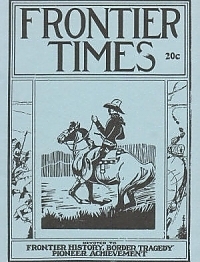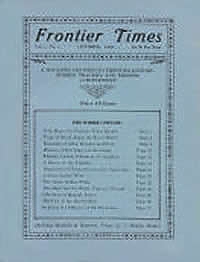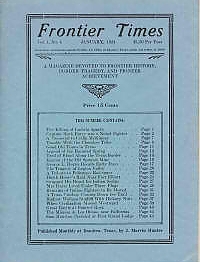By using our website, you agree to the use of cookies as described in our Cookie Policy
Magazines & Instant Downloads
Vol 23 No. 05 - February 1946
When the Cherokees Caused Trouble
By J. Marvin Hunter
In 1836 the 50,000 Texans then fighting for independence from Mexico were beset not only on the western and southern borders of the State, but as well on the northern and eastern borders. On the south and west they had to guard against Mexico enemies and on the north and east against Indians. The tribe from which they had most to fear was the Cherokee. The United States had forced these people, then half-civilized, to migrate to the country west of the Mississippi river, and a portion of the tribe under Chief Bowles had moved and built their homes south of the Red River, and thence had spread across the head-waters of the Sabine river into Texas. Here is the story.
Mentions: Gen. Sam Houston and Col. John Forbes, ,Col. Alexander Horton ,John H. Reagan ,Chief Bowles ,Gen. Edward Burleson ,The Hon. W. G. W. Jowers ,the Killough and Williams families ,one Cordray, a half-breed Mexican ,Lost Prairie, Ark ,Colonel Forbes ,Mr. Lacy ,John Ross ,Kelsey H. Douglas ,Gen. Edward Burleson's regiment ,John Bowles, a son of Chief Bowles ,. Albert Sidney Johnston ,David S. Kaufman ,Dr. Rogers of Nacogdoches *
The Haunted Spring Near Eagle Pass
By Taylor Thompson
Account of a bold spring of water located about thirty miles above Eagle Pass, on the Mexican side of the Rio Grande, where a small rivulet is formed by this spring and flows down a narrow and beautiful valley until its waters are mingled with those of the Bravo del Norte, about half a mile away. In this little valley the grass is green and luxuriant, the wild flowers peculiar to that region abound and the various shrubs and chaparral indigenous to that section grow luxuriantly, while on each side of the valley the soil is arid and usually has a parched appearance, where neither flowers nor grass are to be seen. But the tranquil scene is not all there is to this unusual place. Here is the story.
Mentions: Piedras Negras ,Juan Morales ,St. Kene, in Cornwall *
Massacre of the Russell Family
By John Warren Hunter
“One of the most atrocious murders ever committed on the frontier was the slaughter of the Russell family at their home on Martin's Prairie, Wise county, in August, 1868. Mrs. Polly Russell was a widow with four children. The youngest was a boy of ten years, the next a boy 17, third Martha Russell, a beautiful girl in her teens, and lastly, Bean Russell, a young man. On the day of this shocking tragedy. Mrs. Russell was helplessly surrounded by her three youngest children. On Sandy Creek, some miles distant, the government was operating a saw mill where lumber was being furnished for the building of the post at Fort Richardson, and at this saw mill Bean Russell was working. Although the ever present danger of Indian attack was realized and guarded against in all possible ways, yet this family must earn its living from the soil and must perforce remain upon the exposed farm to achieve that worthy purpose, meanwhile trusting a kindly Providence for safety and protection.
Situated a short distance from Mrs. Russell's house was a large cane patch, and in this patch, at some hour in the forenoon, probably before daylight in the morning, a large party of Indians had found concealment...”
Mentions: Harvey Russell ,Jimmie Russell ,Decatur ,Martha Russell ,Upper Catlett Creek ,J. D. White ,Dick Couch, Jr ,Denton county *
“The hellish work was now begun. Just who fell first or which was the last to fall at the house will never he known. The home was looted and every .article of furniture was wrecked. The window panes and frames were smashed, the feather beds ripped open and their contents thrown to the winds, and all articles of clothing carried off.
No pen, no language can depict the horror of the scene that met the gaze of the faithful toiling son and brother, Bean Russell, when he returned from his day's labor that evening at sundown. His little brother lay dead and mangled in the yard. Across the threshold of the cabin door lay the mother in pools of her own blood. Blood everywhere, and small footprints of crimson, made by the little boy, covered the floor. In vain he called for Harvey and the sister but no response came, and with grief unspeakable he closed the door on the desolate, wrecked and ruined home and hastened towards the saw mill. At dawn the following morning he returned with a party of men to bury the dead. Farther search revealed the body of Harvey Russell under the wreckage in the cabin home, but the sister was nowhere to be found.
During the following day the young man was crazed with the one burning, consuming desire—to find his sister, all the while being oppressed with a certain sense of apprehension that she had been murdered and left in the wilderness to be devoured by wolves. With a party of men from who rallied to his aid he took the trail and followed the Indians. Reaching a point about three miles from home they came upon all that was mortal of poor, a ghastly remnant of the beautiful girl just budding into a joyous womanhood. Wild beasts had torn the flesh from the disjointed frame and near at hand lay the bonnet which the girl had warn at the time of her capture...”
Early Days in the Ministry
By A. W. Young.
Account of Mr. A. W. Young, who was a missionary preacher in the Chickasaw nation.
Mentions: I. T. Morris ,Queen's Peak, nine miles north of Bowie, in Montague county, Texas ,Dripping Springs and Signal Peak about 25 miles above Red River ,Montague county, Texas ,Belcher ,old Spanish Fort, or Burlington ,John Schrock, a saloon-keeper at Spanish Fort ,The old Chisholm trail crossed Red River northwest of the present town of Nocona, Texas ,Belcherville ,Peta Nocona ,Alex Belcher ,the M. K. & T. branch line from Whitesboro to Wichita Falls ,P. W. Horn, ,E. Y. Horn ,Jack Davis ,Dee Hard ,Joe Bailey ,Gainesville ,Judge Charles F. Spencer of Wichita Falls ,Bill Davis ,Tom Garrison and Dee Hart ,Duncan *
Indian Troubles in East Texas
By J. Marvin Hunter
George W. Wood was a native of the State of Alabama and at the age of twenty he married, Miss Jane Killough and came to Texas in 1836. He first settled in Cherokee county just before the war with the Cherokee Indians. They became so dangerous that the settlers went to Nacogdoches county for safety. In the fall, however, it became necessary for them to return to Cherokee county to gather the crops they had planted before leaving. This was in the fall of 1837. While on the way back to their homes Mr. Wood and other settlers met an old friendly Indian who warned them of danger and advised them not to go back into Cherokee county. This advice was not heeded and they proceeded on their way. Here is the story.
Mentions: Allen Killough and his family. ,Miss Killough and Miss Williams ,Michael Young ,Mr. Haynes ,Panfilo de Narvaez
First Masonic Grand Lodge
By J. Marvin Hunter
“Somewhat dimmed by age—it was written one hundred and nine years ago—but still plainly decipherable, the signature of Sam Houston, first president of the Republic of Texas, is attached to the proceedings of the meeting held in Houston, December 20, 1837, at which it was decided to form the Masonic Grand Lodge of Texas. These are found in the first records of the organization, contained in a large leather-bound volume, and stored in the vault of the grand lodge temple at Waco. The first record of a state gathering of Masons of Texas reads as follows...”
Mentions: Holland Lodge No. 36 of A. F. & A. M., ,Brother Anson Jones ,Jeff Wright .and Thomas G. Western ,Thomas J. Rusk, I. W. Burton, Charles. S. Taylor, Adolphus Stern and K. H. Douglas ,McFarland Lodge No. 41, St. Augustine, ,Mr. Winchell ,Mr. Stern ,Holland Lodge No. 36, Houston—Sam Houston, Anson Jones,. Milam No. 40, Nacogdoches ,Adolphus Stern; right worshipful grand junior warden, Jefferson Wright; right worshipful grand junior warden, Christopher Dart; right worshipful grand secretary H Winchell; right worshipful grand treasurer, T. G. Western. ,A. S. Ruthven of Galveston ,John A. Wharton, Asa Brigham, James A. E. Phelps, Alexander Russell ,J. P. Caldwell. ,Asa, Brigham; Junior Warden, J. P. Caldwell. ,J. P. Henderson ,the Tarascan Indians in the Patzcuaro Lake region of Mexico.
$4.95
‹ Back








